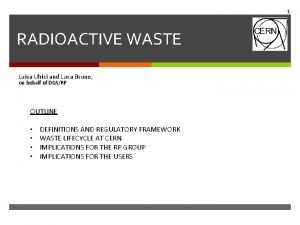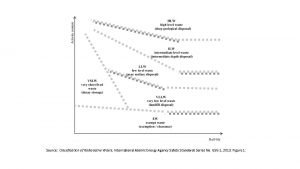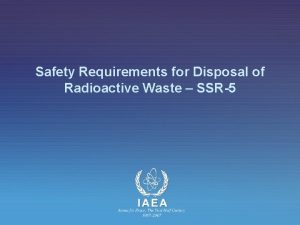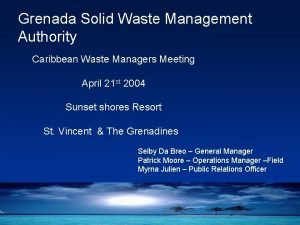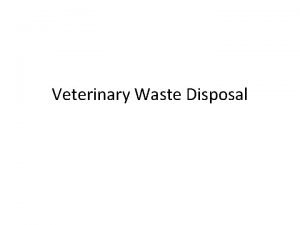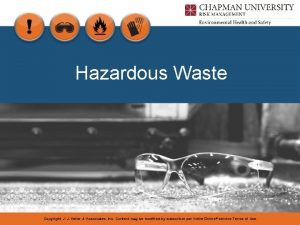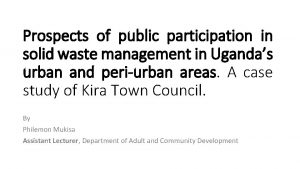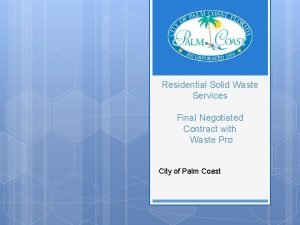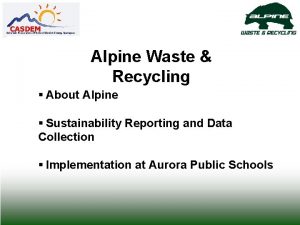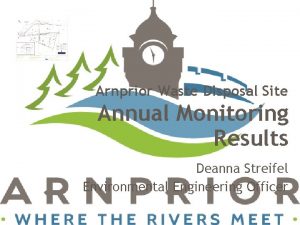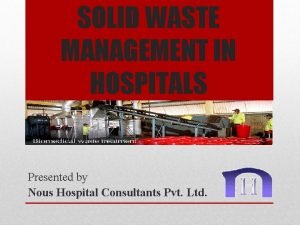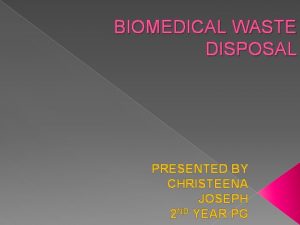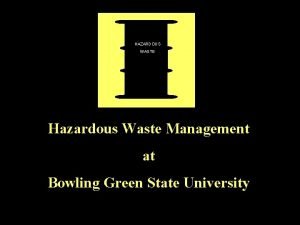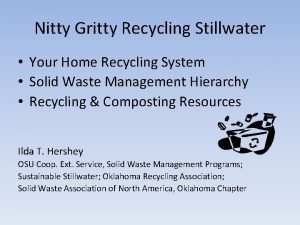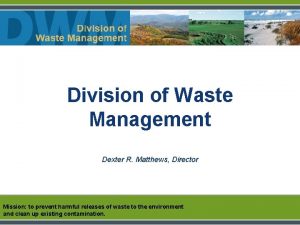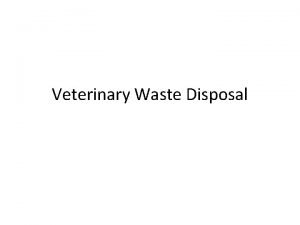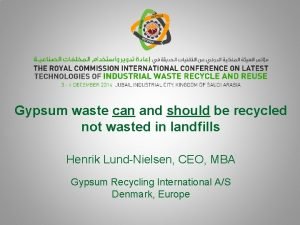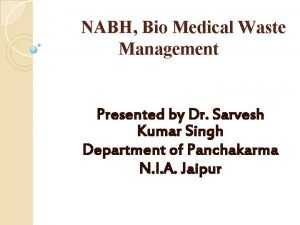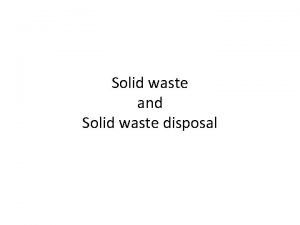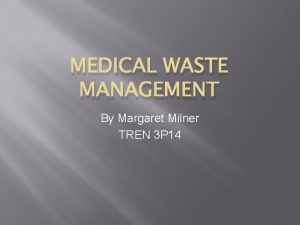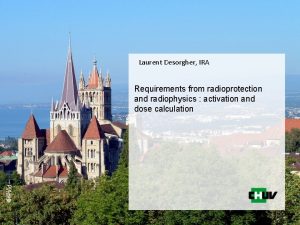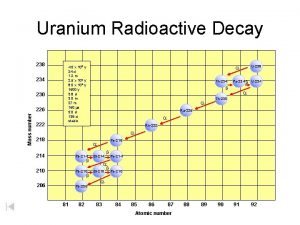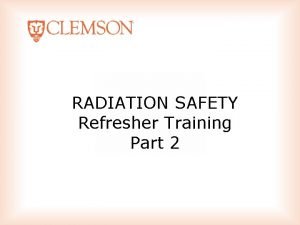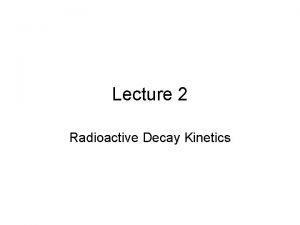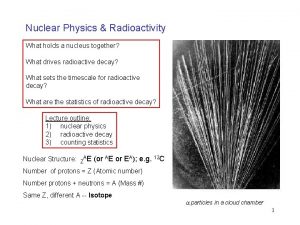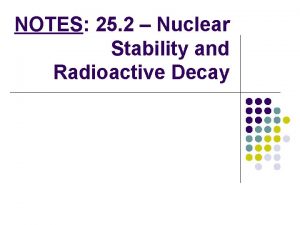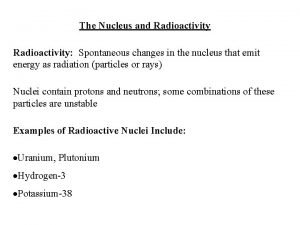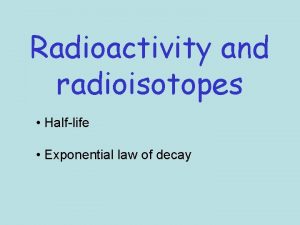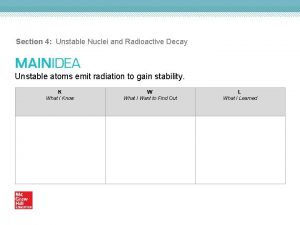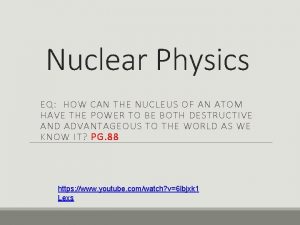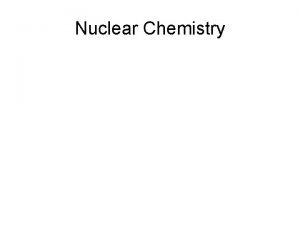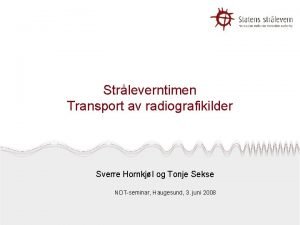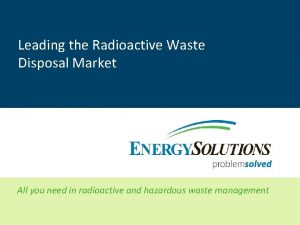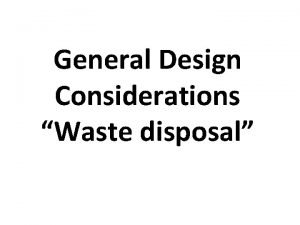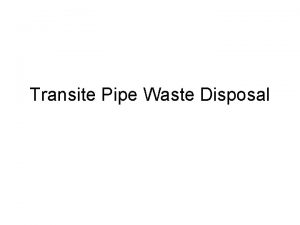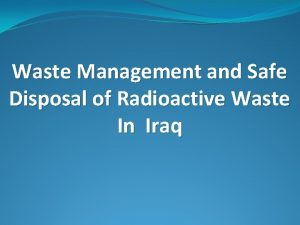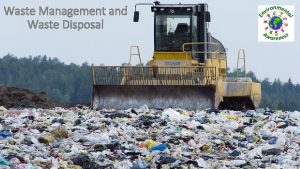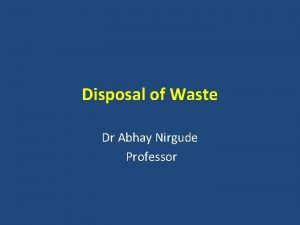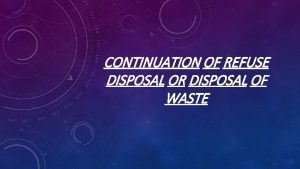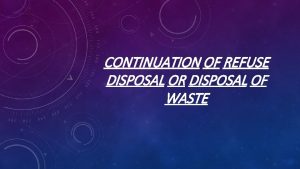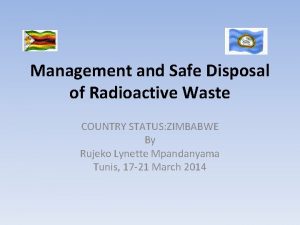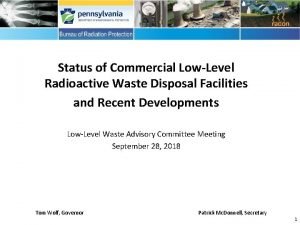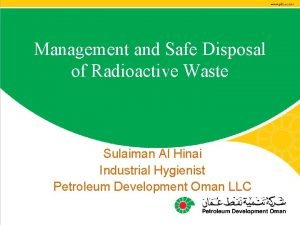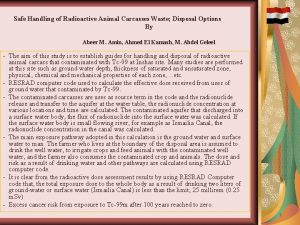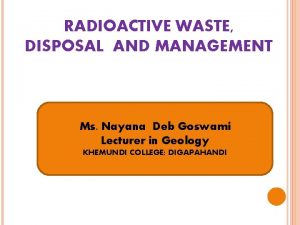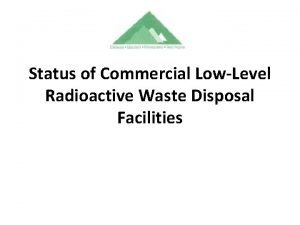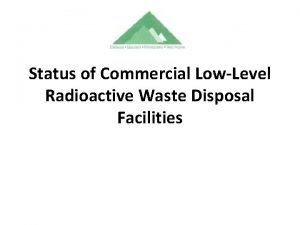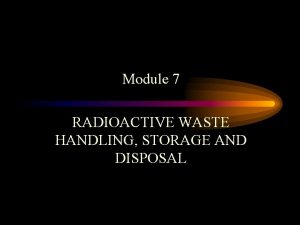Requirements for disposal of radioactive waste SSR5 Presenter









































![Assurance of Safety Requirement 25: Management systems[1] to provide for the assurance of quality Assurance of Safety Requirement 25: Management systems[1] to provide for the assurance of quality](https://slidetodoc.com/presentation_image/55c938de5e7ff9df029cd770d8f65f2d/image-42.jpg)


- Slides: 44

Requirements for disposal of radioactive waste (SSR-5) Presenter Name School of Drafting Regulations for Borehole Disposal of DSRS 2016 Vienna, Austria IAEA International Atomic Energy Agency

Contents Disposal of Radioactive Waste – Specific Safety Requirements • Introduction • Requirements for planning disposal facilities • Requirements for the development, operation and closure of disposal facilities • Requirements for assurance of safety IAEA 2

L 3 Requirements for disposal of radioactive waste (SSR-5) The safety objective is to site, design, construct, operate and close a disposal facility so that protection after its closure is optimised social and economic factors being taken into account. In order to meet the basic objective (to ensure safety), several requirements should be complied with. IAEA 3

Aims of disposal To contain the waste; ü To isolate the waste from the accessible biosphere; ü To inhibit, reduce and delay the migration of radionuclides; ü To ensure that the amounts of radionuclides reaching the accessible biosphere due to any migration from the disposal facility are such that possible radiological consequences are acceptably low at all times. ü Disposal facilities are not expected to provide complete containment and isolation of waste over all time; this is neither practicable nor necessitated by the hazard associated with waste, which declines with time. IAEA 4

The specific aims of disposal: SOURCE SAFETY FUNCTIONS RECEIPIENT CONTAIN B W OBJECTIVE I A ISOLATE O S S T INHIBIT, REDUCE, DELAY E P ACCEPTABLY LOW IMPACT H R E IAEA 5

The residual material (waste) hierarchy Avoid Reduce Reuse Predisposal Recycle Treat Dispose IAEA 6

Safety standards are not legally binding on MS but may be adopted by them. Safety standards are binding on the IAEA in relation to its own operations. Basic objectives, concepts and principles of safety and protection That must be met to ensure safety Recommend actions, conditions or procedures for meeting safety requirements IAEA 7

Relevant Documents 1999 2011 2006 IAEA 2006 8

Disposal The term ‘disposal’ refers to the emplacement of radioactive waste into a facility or a location with no intention of retrieving the waste. (The term disposal implies that retrieval is not intended; it does not mean that retrieval is not possible. ) Disposal options are designed to contain the waste by means of passive engineered and natural features and isolate it from the accessible biosphere to the extent necessitated by the associated hazard. IAEA 9

Safety Requirements applies to all of the types of disposal and disposal facilities In order to meet the basic objective (to ensure safety), several requirements should be complied with. IAEA 10

SCOPE • Applies to the disposal of radioactive waste of all types • Establishes requirements to provide assurance of radiological safety • During the operational period and • Especially in the post-closure period • Does not address • Broader issues of site selection • Transportation of waste to the site • Non radiological environmental impact • Stakeholder involvement important, but beyond the scope of the standard IAEA 11

Means for achieving safety Safety in the operation of radioactive waste disposal facilities has to be achieved by means of a variety of engineered and operational controls. • These include the containment and shielding for the radioactive waste and operational control over time of exposure and proximity to the waste. Safety after closure is achieved by developing a disposal system in which the various components work together to provide and to ensure the required level of safety. Protection of the public is provided for by preventing or controlling releases from the facility and by controlling access to the site. IAEA 12

Waste types & relevant disposal options VSLW VLLW ILW HLW Activity, half-life IAEA 13

Safety Requirements applies to all of the types of disposal and disposal facilities • • • Specific landfill disposal Near surface disposal Disposal of intermediate level waste Geological disposal Borehole disposal Disposal of mining and minerals processing waste • Safety Guides provide comprehensive guidance on and international best practices for meeting the requirements in respect of different types of disposal facility. IAEA 14

Protection of people and the environment The IAEA Safety Fundamentals publication Fundamentall Safety Principles sets out the fundamental safety objective and safety principles that apply for all facilities and activities in radioactive waste management, including the disposal of radioactive waste. • The ICRP developed a System of Radiological Protection that applies to all facilities and activities, and this system was adopted in the International Basic Safety Standards. The ICRP has elaborated the application of the System of Radiological Protection to the disposal of solid radioactive waste in its Publications 77 and 81 which it reconfirmed in Publication 103. • This provides a starting point for the safety considerations relation to disposal facilities. NOTE. Radiation protection in the operational period and in the Post IAEA Closure period will be addressed in other lecture. 15

Safety Requirements for Planning Disposal Facilities IAEA 16

Governmental, Legal and Regulatory Framework Requirement 1: Government responsibilities The government is required to establish and maintain an appropriate governmental, legal and regulatory framework for safety within which responsibilities are clearly allocated for disposal facilities for radioactive waste to be sited, designed, constructed, operated and closed. This shall include: confirmation at a national level of the need for disposal facilities of different types; specification of the steps in development and licensing of facilities of different types; and clear allocation of responsibilities, securing of financial and other resources, and provision of independent regulatory functions relating to a planned disposal facility. IAEA 17

Governmental, Legal and Regulatory Framework Requirement 2: Responsibilities of the regulatory body The regulatory body shall establish regulatory requirements for the development of different types of disposal facility for radioactive waste and shall set out the procedures for meeting the requirements for the various stages of the licensing process. It shall also set conditions for the development, operation and closure of each individual disposal facility and shall carry out such activities as are necessary to ensure that the conditions are met. IAEA 18

Governmental, Legal and Regulatory Framework Requirement 3: Responsibilities of the operator The operator of a disposal facility for radioactive waste shall be responsible for its safety. The operator shall carry out safety assessment and develop and maintain a safety case, and shall carry out all the necessary activities for site selection and evaluation, design, construction, operation, closure and, if necessary, surveillance after closure, in accordance with national strategy, in compliance with the regulatory requirements and within the legal and regulatory infrastructure. IAEA Lecture 6. 1 - Requirements for Safe Disposal 19

Safety Approach Requirement 4: Importance of safety in the process of development and operation of a disposal facility. Throughout the process of development and operation of a disposal facility for radioactive waste, an understanding of the relevance and the implications for safety of the available options for the facility shall be developed by the operator. This is for the purpose of providing an optimized level of safety in operational stage and after closure. IAEA 20

Safety Approach Requirement 5: Passive means for the safety of the disposal facility The operator shall evaluate the site and shall design, construct, operate and close the disposal facility in such a way that safety is ensured by passive means to the fullest extent possible and the need for actions to be taken after closure of the facility is minimized. IAEA Lecture 6. 1 - Requirements for Safe Disposal 21

Safety Approach Requirement 6: Understanding of a disposal facility and confidence in safety The operator of a disposal facility shall develop an adequate understanding of the features of the facility and its host environment and of the factors that influence its safety after closure over suitably long time periods, so that a sufficient level of confidence in safety can be achieved. IAEA Lecture 6. 1 - Requirements for Safe Disposal 22

Design Concepts for Safety Requirement 7: Multiple safety functions The host environment shall be selected, the engineered barriers of the disposal facility shall be designed and the facility shall be operated to ensure that safety is provided by means of multiple safety functions. Containment and isolation of the waste shall be provided by means of a number of physical barriers of the disposal system. The performance of these physical barriers is achieved by means of diverse physical and chemical processes together with various operational controls. The capability of the individual barriers and controls together with that of the overall disposal system to perform as assumed in the safety case shall be demonstrated. The overall performance of the disposal system shall not be unduly dependent on a single safety function. IAEA 23

Design Concepts for Safety Requirement 8: Containment of radioactive waste The engineered barriers, including the waste form and packaging, shall be designed, and the host environment shall be selected, so as to provide containment of the radionuclides associated with the waste. Containment shall be provided until radioactive decay has significantly reduced the hazard posed by the waste. In the case of heat generating waste, containment shall be provided while the waste is still producing heat energy in amounts that could adversely affect the performance of the disposal system. IAEA 24

Design Concepts for Safety Requirement 9: Isolation of radioactive waste The disposal facility shall be sited, designed and operated to provide features that are aimed at isolation of the radioactive waste from people and from the accessible biosphere. The features shall aim to provide isolation for several hundreds of years for short lived waste and at least several thousand years for intermediate and high level waste. In so doing, consideration shall be given to both the natural evolution of the disposal system and events causing disturbance of the facility. IAEA 25

Design Concepts for Safety Requirement 10: Surveillance and control of passive safety features An appropriate level of surveillance and control shall be applied to protect and preserve the passive safety features, to the extent that this is necessary, so that they can fulfil the functions that they are assigned in the safety case for safety after closure. IAEA Lecture 6. 1 - Requirements for Safe Disposal 26

REQUIREMENTS FOR THE DEVELOPMENT, OPERATION AND CLOSURE OF A DISPOSAL FACILITY IAEA 27

Framework for Disposal of Radioactive Waste Requirement 11: Step by step development and evaluation of disposal facilities Disposal facilities for radioactive waste shall be developed, operated and closed in a series of steps. Each of these steps shall be supported, as necessary, by iterative evaluations of the site, of the options for design, construction, operation and management, and of the performance and safety of the disposal system. IAEA 28

The Safety Case and Safety Assessment Requirement 12: Preparation, approval and use of the safety case and safety assessment for a disposal facility. A safety case and supporting safety assessment shall be prepared and updated by the operator, as necessary, at each step in the development of a disposal facility, in operation and after closure. The safety case and supporting safety assessment shall be submitted to the regulatory body for approval. The safety case and supporting safety assessment shall be sufficiently detailed and comprehensive to provide the necessary technical input for informing the regulatory body and for informing the decisions necessary at each step. IAEA 29

The Safety Case and Safety Assessment Requirement 13: Scope of the safety case and safety assessment The safety case for a disposal facility shall describe all safety relevant aspects of the site, the design of the facility, and the managerial control measures and regulatory controls. The safety case and supporting safety assessment shall demonstrate the level of protection of people and the environment provided and shall provide assurance to the regulatory body and other interested parties that safety requirements will be met. IAEA 30

The Safety Case and Safety Assessment Requirement 14: Documentation of the safety case and safety assessment The safety case and supporting safety assessment for a disposal facility shall be documented to a level of detail and quality sufficient to inform and support the decision to be made at each step and to allow for independent review of the safety case and supporting safety assessment. IAEA 31

Steps in the Development, Operation and Closure of a Disposal Facility Requirement 15: Site characterization for a disposal facility. The site for a disposal facility shall be characterized at a level of detail sufficient to support a general understanding of both the characteristics of the site and how the site will evolve over time. This shall include its present condition, its probable natural evolution, and possible natural events and also human plans and actions in the vicinity that may affect the safety of the facility over the period of interest. It shall also include a specific understanding of the impact on safety of features, events and processes (FEPs) associated with the site and the facility. IAEA 32

Steps in the Development, Operation and Closure of a Disposal Facility Requirement 16: Design of a disposal facility. The disposal facility and its engineered barriers shall be designed to contain the waste with its associated hazard, to be physically and chemically compatible with the host geological formation and/or surface environment, and to provide safety features after closure that complement those features afforded by the host environment. The facility and its engineered barriers shall be designed to provide safety during the operational period. IAEA 33

Steps in the Development, Operation and Closure of a Disposal Facility Requirement 17: Construction of a disposal facility The disposal facility shall be constructed in accordance with the design as described in the approved safety case and supporting safety assessment. It shall be constructed in such a way as to preserve the safety functions of the host environment that have been shown by the safety case to be important for safety after closure. Construction activities shall be carried out in such a way as to ensure safety during the operational period. IAEA 34

Steps in the Development, Operation and Closure of a Disposal Facility Requirement 18: Operation of a disposal facility The disposal facility shall be operated in accordance with the conditions of the licence and the relevant regulatory requirements so as to maintain safety during the operational period, and in such a manner as to preserve the safety functions assumed in the safety case that are important to safety after closure. IAEA 35

Steps in the Development, Operation and Closure of a Disposal Facility Requirement 19: Closure of a disposal facility A disposal facility shall be closed in a way that provides for those safety functions that have been shown by the safety case to be important after closure. Plans for closure, including the transition from active management of the facility, shall be well defined and practicable, so that closure can be carried out safely at an appropriate time. IAEA 36

Assurance of Safety Requirement 20: Waste acceptance in a disposal facility Waste packages and unpackaged waste accepted for emplacement in a disposal facility shall conform to criteria that are fully consistent with and are derived from the safety case for the disposal facility in operation and after closure. IAEA 37

Assurance of Safety Requirement 21: Monitoring programmes at a disposal facility A programme of monitoring shall be carried out prior to and during the construction and operation of a disposal facility, and after its closure, if this is part of the safety case. This programme shall be designed to collect and update information necessary for the purposes of protection and safety. Information shall be obtained to confirm the conditions necessary for the safety of workers and members of the public and protection of the environment during the period of operation of the facility. Monitoring shall also be carried out to confirm the absence of any conditions that could affect the safety of the facility after closure. IAEA 38

Assurance of Safety Requirement 22: The period after closure and institutional controls Plans shall be prepared for the period after closure to address institutional control and the arrangements for maintaining the availability of information on the disposal facility. These plans shall be consistent with passive safety features and shall form part of the safety case on which authorization to close the facility is granted. IAEA 39

Assurance of Safety Requirement 23: Consideration of the State system of accounting for and control of nuclear material[1] In the design and operation of disposal facilities subject to agreements on accounting for and control of nuclear material, consideration shall be given to ensuring that safety is not compromised by the measures required under the system of accounting for and control of nuclear material State systems of accounting for and control of nuclear material are required by IAEA nuclear safeguards agreements. IAEA 40

Assurance of Safety Requirement 24: Requirements in respect of nuclear security measures. Measures shall be implemented to ensure an integrated approach to safety measures and nuclear security measures in the disposal of radioactive waste. IAEA Lecture 6. 1 - Requirements for Safe Disposal 41
![Assurance of Safety Requirement 25 Management systems1 to provide for the assurance of quality Assurance of Safety Requirement 25: Management systems[1] to provide for the assurance of quality](https://slidetodoc.com/presentation_image/55c938de5e7ff9df029cd770d8f65f2d/image-42.jpg)
Assurance of Safety Requirement 25: Management systems[1] to provide for the assurance of quality shall be applied to all safety related activities, systems and components throughout all the steps of the development and operation of a disposal facility. The level of assurance for each element shall be commensurate with its importance to safety. [1] The term management system includes all the initial concepts of quality control (controlling the quality of products) and its evolution through quality assurance (the system for ensuring the quality of products) and quality management (the system for managing quality). IAEA 42

Existing Disposal Facilities Requirement 26: Existing disposal facilities The safety of existing disposal facilities shall be assessed periodically until termination of the licence. During this period, the safety shall also be assessed when a safety significant modification is planned or in the event of changes with regard to the conditions of the authorization. In the event that any requirements set down in this publication are not met, measures shall be put in place to upgrade the safety of the facility, economic and social factors being taken into account. IAEA Lecture 6. 1 - Requirements for Safe Disposal 43

IAEA Thank you! 44
 Radioactive waste
Radioactive waste How to get rid of radioactive waste
How to get rid of radioactive waste Radioactive nuclear waste
Radioactive nuclear waste Ssr5
Ssr5 Ssr 5
Ssr 5 Waste management definition
Waste management definition Waste companies grenada
Waste companies grenada Veterinary waste disposal guidelines
Veterinary waste disposal guidelines Hazardous waste transportation
Hazardous waste transportation Solid waste disposal introduction
Solid waste disposal introduction Dr neha agrawal
Dr neha agrawal Waste pro
Waste pro Alpine waste disposal
Alpine waste disposal Arnprior waste disposal site
Arnprior waste disposal site Color coding for waste disposal
Color coding for waste disposal Trash haulers grenada
Trash haulers grenada Introduction of biomedical waste
Introduction of biomedical waste Waste disposal bowling green
Waste disposal bowling green Stillwater ok recycling
Stillwater ok recycling Medico waste disposal
Medico waste disposal Matthews waste disposal
Matthews waste disposal Waste disposal lyndon
Waste disposal lyndon Disposing of veterinary clinical waste
Disposing of veterinary clinical waste Disposal of gypsum waste
Disposal of gypsum waste Nabh criteria for hospital
Nabh criteria for hospital Waste collection lindsay
Waste collection lindsay Bangalore method of composting
Bangalore method of composting Milner waste
Milner waste 3 waste management
3 waste management Radioactive decay formula
Radioactive decay formula Is lead radioactive
Is lead radioactive Caution radioactive material
Caution radioactive material Isotope decay formula
Isotope decay formula Radioactive decay law
Radioactive decay law Half life example
Half life example Positron emission equation
Positron emission equation Law of exponential decay
Law of exponential decay Radioactive tracers in agriculture
Radioactive tracers in agriculture Type of radioactive decay
Type of radioactive decay How unstable atoms gain stability
How unstable atoms gain stability Beta minus decay
Beta minus decay Chapter 24 nuclear chemistry answer key
Chapter 24 nuclear chemistry answer key Chemistry images
Chemistry images Un3332 radioactive material
Un3332 radioactive material Energy solutions barnwell sc
Energy solutions barnwell sc
